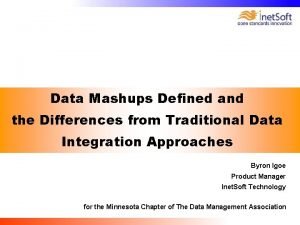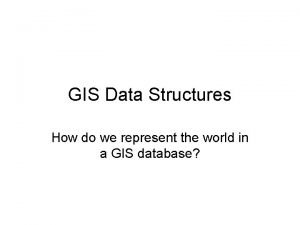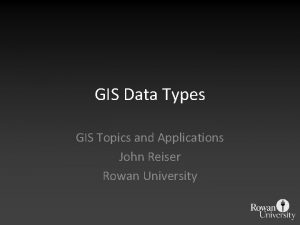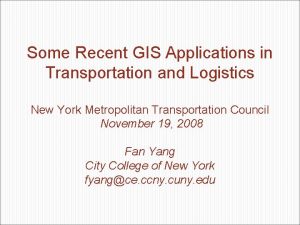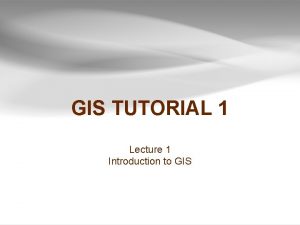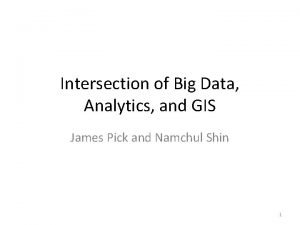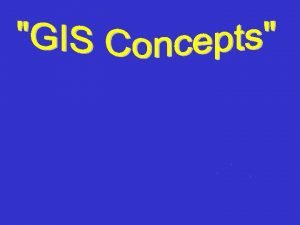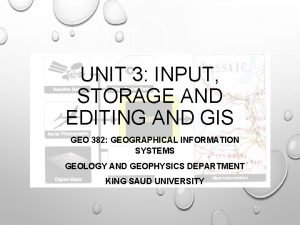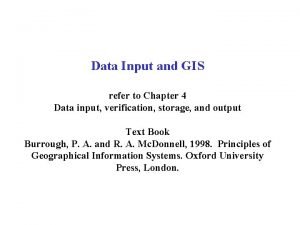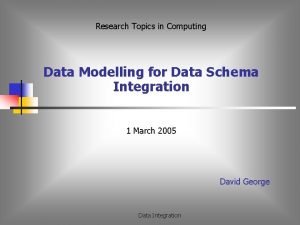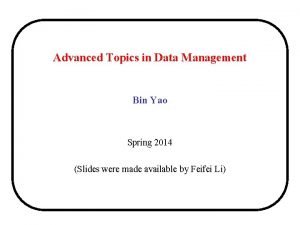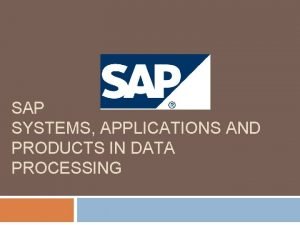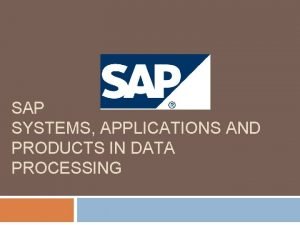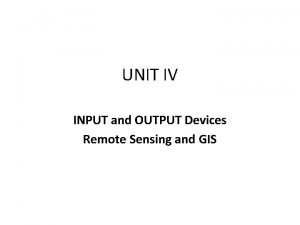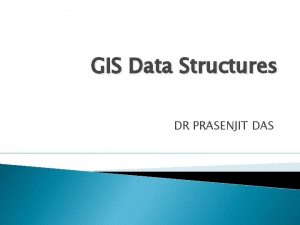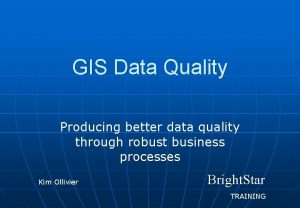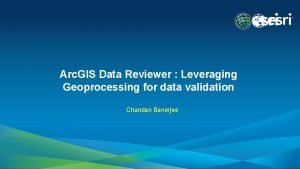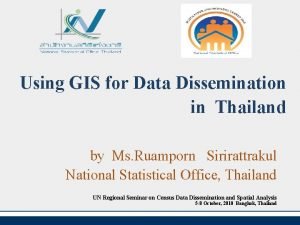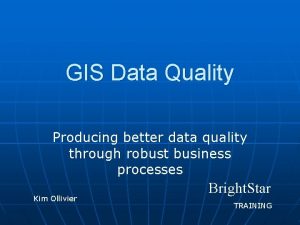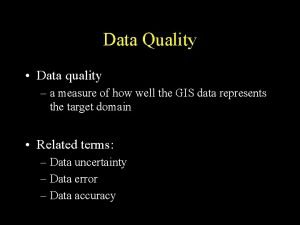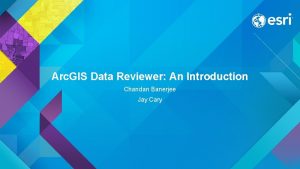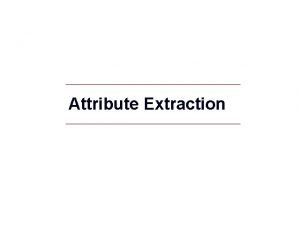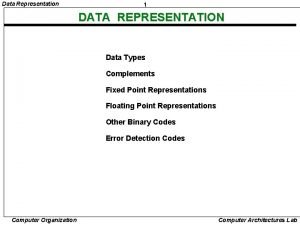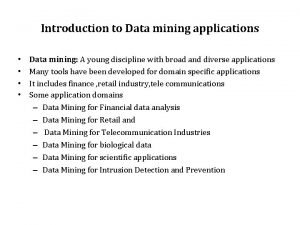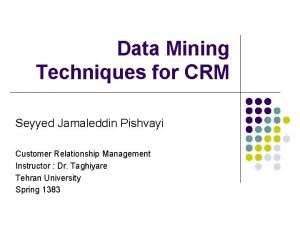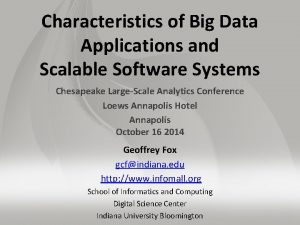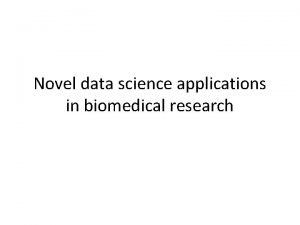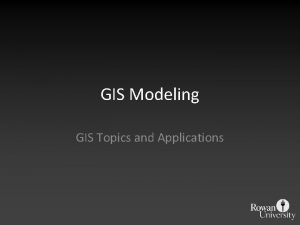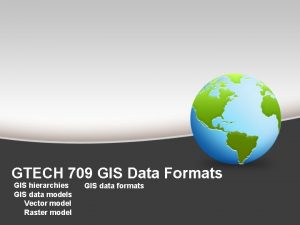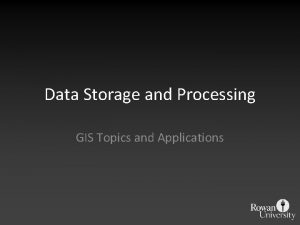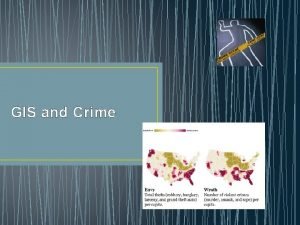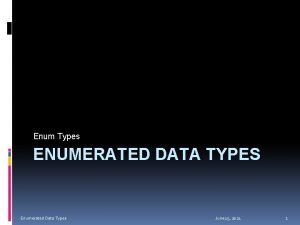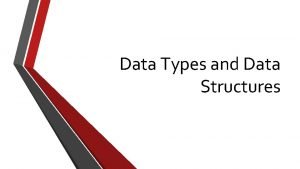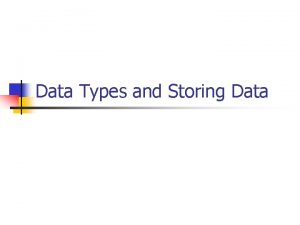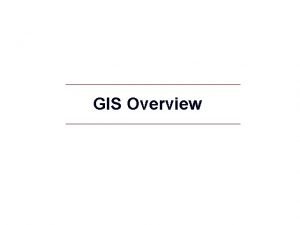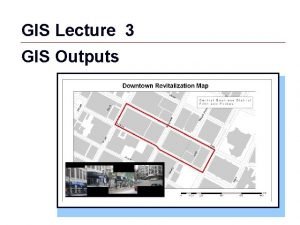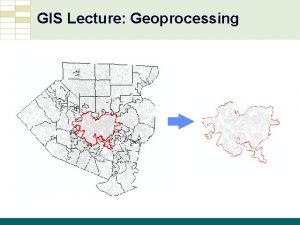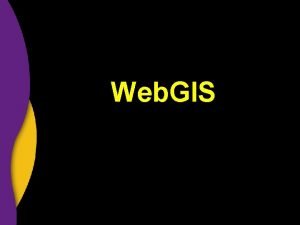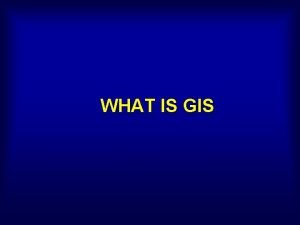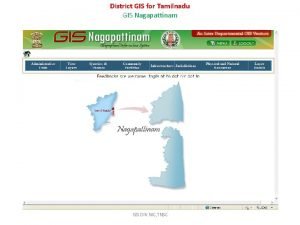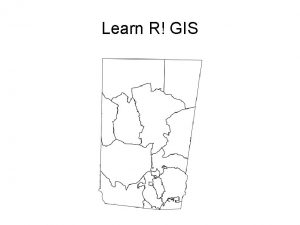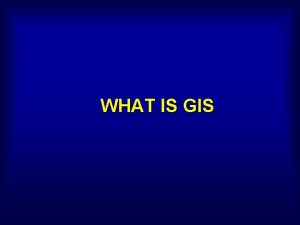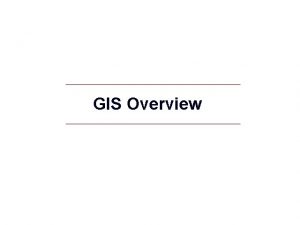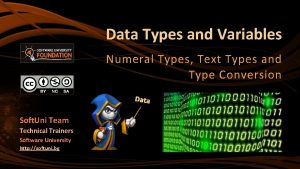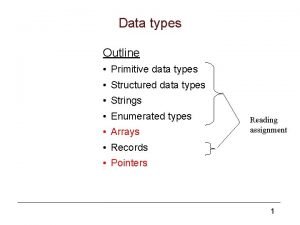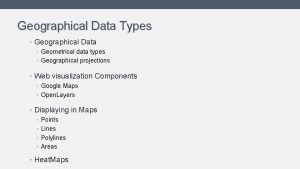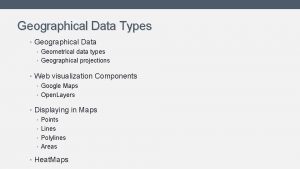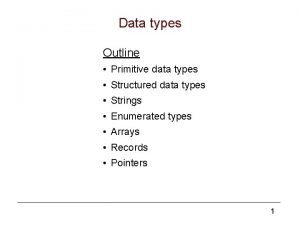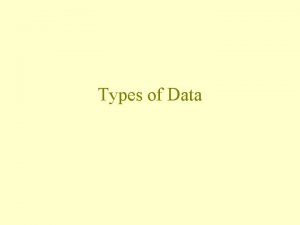GIS Data Types GIS Topics and Applications John

































- Slides: 33

GIS Data Types GIS Topics and Applications John Reiser Rowan University

Data Types • Two Major Families of GIS Data – Raster – Vector • Raster is grid based • Vector is: – coordinate based (cartesian, polar, 3 D, linear) – topological – object oriented

Coding Raster GIS Data 1 1 1 2 3 1 1 1 Reality 1 1 2 2 3 1 1 1 1 2 2 3 3 5 6 1 1 3 3 3 4 5 5 5 1 4 4 4 4 5 5 5 5 Raster Model of Reality

Raster Limitations • Raster grid must cover the entire study area. • Files can grow to enormous sizes for large study areas with small cell sizes. • Attributes are limited and linking to tabular data is impractical. • Adjacency is easy to determine, but topology is lacking. • Raster grid cells are not “aware” and cannot have actions attached to them in the geodatabase.

Vector Data • We represent points, lines and polygons with vector data. • Moving away from shapefiles, we can store multipoints, annotation, dimensions, coordinate geometry, cadastral fabrics, networks and multipatches (3 D objects) in the geodatabase as vector data.

Y 1 2 3 4 Point 1 2 X X 1 X 2 Y Y 1 Y 2 3 4 X 3 X 4 Y 3 Y 4 X Points in the World Out There Vector Encoding Points Resulting Image

Y Line 1 1 Node X 11 X 12 4 X Y 11 Y 12. . . X 1 n Y 1 n 2 X 21 X 2 n Y 21 Y 2 n 3 X 31 X 32 Y 31 Y 32 . . . Lines in the World Out There Vertex Y . . . 3 2 X X 3 n 4 X 41 X 4 n . . . Y 3 n Y 41 Y 4 n Vector Encoding Lines Resulting Image

Polygons and Multiparts • Polygons must close upon themselves, so that the first and last vertex are the same. • Polygons may include internal rings that act as “donut holes” – areas excluded from the surrounding polygon. • Polygons (and points and lines) may also include multiple parts.

Attributes • Each vector feature has an accompanying record in the database. • In its simplest form, one feature has one record in the attribute table. • We can store multiple vector objects in one database record. • Multipoints, polylines and multipolygons store a series of vector objects as one feature and one attribute table record.

Multipart Features • When we store multiple geometries as one record, we refer to them as multipart features. • Arc. GIS will – by default – create multipart features as outputs from Arc. Toolbox. • Let’s look at some real world examples…

Enclaves and Exclaves • Long Beach is a Township in Ocean County. It’s in four separate pieces on LBI. • Storing it as one record makes sense – it’s one township, not four. • Nearby Tuckerton is an enclave within Little Egg Harbor Township.

LIDAR Data • Lidar data is 3 D elevation data recorded from an airplane. • Stored as “mass points” – even a small area is composed of thousands of point features. • To lower overhead, the points are stored as multipoints – roughly 3, 500 points per attribute table record. • No real need for attributes, simply XYZ points.

Why do we do this? • Depends on the structure of our data model. • Possibly lower overhead; easier processing. • Normalization – DB Normalization is a key component of database design. – Less redundancy – Update attributes in one place, instead of multiple – Keeps it simple, students. (Admittedly, it’s usually more time to set up, but much lower cost to maintain. )

Best Practices • There are many ways to represent reality digitally. • GIS and DB “Best Practices” are exactly that – the (or one of) best way to handle a situation, regardless of software and hardware. • Even though we’ll primarily deal with Arc. GIS, thinking about “the best way” is the only way that you can be sure you’re effectively managing your GIS system.

Smart Objects • Vector features can follow rules and have “business logic”. • Still composed of points, lines, and/or polygons, these objects are higher-level models of reality. • Topology-based Rulemaking • Cadastral Fabric • Networks • Terrain Models

What is Topology? • Shared Geometries, Adjacency and Overlap • Where points, lines, and polygons share individual vertices. Move a point and it moves a vertex in a line/polygon, and vice versa. • Two polygons that share vertices are considered adjacent. • Overlapping (or non-overlapping) features can be located, and then marked as errors.

Simple Example • The boundaries of two properties should never overlap, and there should never be a gap between them, unless intentional. • Clear error in parcel boundaries.

Policy-based Topology Rules • In the NJ State Plan, CESs and the Environmentally Sensitive Planning Area both represent areas of environmental importance. – Thus, CESs should never be placed on top of the ES Planning Area. • In our utility network, poles hold up the transmission lines. – The transmission line features must always share a vertex with the utility pole point features.

Networks • Analysis can be performed across a network, represented by a feature dataset of points and lines. • Road network or water, sewer, utility, rail, etc… • Optimal route – shortest, lowest cost, avoiding left turns, follow height and weight restrictions, time of day restrictions, include real-time traffic… • Multi-modal – walk/bike to bus stop, bus to train, walk from train to final destination.

GIS is extensible • With modern GIS, a polygon is not just a polygon. • Software can be adapted to fit your model of reality. • The software can be easily extended to create new data types and perform new analyses. • GIS can be adapted to store, model, and display data about any observable phenomenon on the Earth.

Different GIS Models • Almost every GIS defines features on the Earth using one of two methods: – Point or series of points (Vector) – Grid cells or group of cells (Raster) • Other than that, how those pieces fit together to represent reality is entirely dependent on the GIS model. • Let’s look at Open. Street. Map.

Open. Street. Map • OSM was developed by British developers. • The Ordinance Survey (analogue to the USGS) completely restricts the use of their data through high licensing costs. • OSM was developed to be an open, license-free map of the World. • You are allowed to edit and update the map, provided your contributions are not encumbered by licensing issues.

OSM Data Primitives • Unlike what we’ve used before, OSM has an entirely different way of storing GIS data. • With Arc. GIS, we store a set of layers – Polygon shapefile: lakes, parks, etc… – Line feature class: roads, rails, streams, etc… – Point shapefile: points of interest, water towers, etc… – Annotation: place name labels, and so on… • OSM stores everything in one big database. • All features can share parts – topology.

Data Primitives • Nodes – Most basic unit – building block of all others. – One latitude/longitude coordinate pair. – Can have its own attributes. • Ways – Series of nodes denoting a linear feature or an area. – Open way – linear feature – roadway, rail, etc. – Closed way – areal feature – lake, building, etc. • Relations – Grouping ways and nodes.

Attributes • No attribute table with defined field names. • Attributes are free form – want to tag something where “rowan”=“awesome”? Nothing’s stopping you! • Unknown tags won’t influence rendering of the map. • Huge list of well known, renderable tags.

Extensibility • OSMs open data structure and licensing has allowed for many adaptations of the data. • Rendering: – Mapnik and Osmarender – Cycle. Map, Hike and Bike • Web Services – European WMS Service – Routing

Extensibility • University of Maryland – College Park uses OSM for its campus map. • Map is routable, giving you walking directions between buildings. • Routing can be "accessiblity-aware" routing you around stairs, unstriped crosswalks, etc.

Versioning • Each data element is tracked and each previous version is maintained. • User accounts required to track edits. • Mistakes can be easily reverted to their previous version, provided no subsequent changes have been made. • Versioning & multi-user editing are available in Arc. GIS using managed geodatabases.

Real World: Haiti • In response to the earthquake in Haiti, OSM users from around the world digitized donated satellite imagery taken after the event. • Users coordinated their efforts on the OSM wiki. • Relief workers on the ground and coordinators are using the OSM data to help recovery.

Contributing to OSM • OSM needs updates and refinements to keep the map current and detailed. • Offer several methods to update: – Walking Papers (printed maps) – GPX (GPS e. Xchange format) uploads – Potlatch (in browser editing) – JOSM (standalone editor)

JOSM • The Java OSM editor is perhaps the most feature-rich editor available for OSM. • Plugins allow for the verification of topology and tags and the use of WMS services. • Just like OSM, it is free, open source software.

Contributing to OSM • Create an account and send me your username. • Locate an area lacking detail. It can be around your hometown or some place you feel comfortable. • Research the area. Use Walking Papers, GPS, and the NJ aerial photography to help you update. • Be creative with what can be mapped: bike racks and pedestrian paths within parks (and the parks themselves).

A Note: NJ Land Use • I added the Land Use data for NJ from the data available on the DEP's website. • Despite heavy messaging, it can still be difficult to edit in OSM, so be careful. • It is from 2002, so if you find ways tagged with "landuse"="construction" explore them to see what was added in the 2002 -2007 time period. • Don't hesitate to ask for help!
 Enterprise data mashup
Enterprise data mashup Google earth
Google earth Spatial data structures in gis
Spatial data structures in gis Gis data types
Gis data types Gis applications in transportation
Gis applications in transportation Gis applications in civil engineering
Gis applications in civil engineering Big data and gis
Big data and gis Gis definition
Gis definition Data entry in gis
Data entry in gis Data entry in gis
Data entry in gis Data warehouse research topics
Data warehouse research topics Data management topics
Data management topics Systems, applications, products in data processing
Systems, applications, products in data processing Sap systems applications and products in data processing
Sap systems applications and products in data processing What is the inputting device for gis?
What is the inputting device for gis? Gis data structure
Gis data structure Gis data quality
Gis data quality Gis data validation
Gis data validation Giscont
Giscont Data quality in gis
Data quality in gis Micro and macro components of accuracy in gis
Micro and macro components of accuracy in gis Gis data validation
Gis data validation Polk county gis data
Polk county gis data Attribute data query in gis
Attribute data query in gis Descriptive mining of complex data objects
Descriptive mining of complex data objects Types of data representation
Types of data representation Mining complex data types
Mining complex data types Complex data types in data mining
Complex data types in data mining Spatial data mining applications
Spatial data mining applications Data mining in crm
Data mining in crm Characteristics of big data applications
Characteristics of big data applications Data driven web applications
Data driven web applications Novel data science applications
Novel data science applications Informative and surprising essay
Informative and surprising essay
